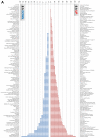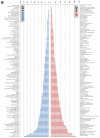Unraveling the ischemic brain transcriptome in a permanent middle cerebral artery occlusion mouse model by DNA microarray analysis
- PMID: 22015461
- PMCID: PMC3291648
- DOI: 10.1242/dmm.008276
Unraveling the ischemic brain transcriptome in a permanent middle cerebral artery occlusion mouse model by DNA microarray analysis
Abstract
Brain ischemia, also termed cerebral ischemia, is a condition in which there is insufficient blood flow to the brain to meet metabolic demand, leading to tissue death (cerebral infarction) due to poor oxygen supply (cerebral hypoxia). Our group is interested in the protective effects of neuropeptides for alleviating brain ischemia, as well as the underlying mechanisms of their action. The present study was initiated to investigate molecular responses at the level of gene expression in ischemic brain tissue. To achieve this, we used a mouse permanent middle cerebral artery occlusion (PMCAO) model in combination with high-throughput DNA microarray analysis on an Agilent microarray platform. Briefly, the right (ipsilateral) and left (contralateral) hemispheres of PMCAO model mice were dissected at two time points, 6 and 24 hours post-ischemia. Total RNA from the ischemic (ipsilateral) hemisphere was subjected to DNA microarray analysis on a mouse whole genome 4x44K DNA chip using a dye-swap approach. Functional categorization using the gene ontology (GO, MGD/AMIGO) of numerous changed genes revealed expression pattern changes in the major categories of cellular process, biological regulation, regulation of biological process, metabolic process and response to stimulus. Reverse-transcriptase PCR (RT-PCR) analysis on randomly selected highly up- or downregulated genes validated, in general, the microarray data. Using two time points for this analysis, major and minor trends in gene expression and/or functions were observed in relation to early- and late-response genes and differentially regulated genes that were further classified into specific pathways or disease states. We also examined the expression of these genes in the contralateral hemisphere, which suggested the presence of bilateral effects and/or differential regulation. This study provides the first ischemia-related transcriptome analysis of the mouse brain, laying a strong foundation for studies designed to elucidate the mechanisms regulating ischemia and to explore the neuroprotective effects of agents such as target neuropeptides.
Figures






References
-
- Albaiceta G. M., Gutierrez-Fernández A., García-Prieto E., Puente X. S., Parra D., Astudillo A., Campestre C., Cabrera S., Gonzalez-Lopez A., Fueyo A., et al. (2010). Absence or inhibition of matrix metalloproteinase-8 decreases ventilator-induced lung injury. Am. J. Respir. Cell Mol. Biol. 43, 555–563 - PubMed
-
- Altman N. (2005). Replication, variation and normalisation in microarray experiments. Appl. Bioinformatics 4, 33–44 - PubMed
-
- Brait V. H., Rivera J., Broughton B. R., Lee S., Drummond G. R., Sobey C. G. (2011). Chemokine-related gene expression in the brain following ischemic stroke: no role for CXCR2 in outcome. Brain Res. 1372, 169–179 - PubMed
-
- Büttner F., Cordes C., Gerlach F., Heimann A., Alessandri B., Luxemburger U., Türeci O., Hankeln T., Kempski O., Burmester T. (2008). Genomic response of the rat brain to global ischemia and reperfusion. Brain Res. 1252, 1–14 - PubMed
-
- Cauwe B., Van den Steen P. E., Opdenakker G. (2007). The biochemical, biological, and pathological kaleidoscope of cell surface substrates processed by matrix metalloproteinases. Crit. Rev. Biochem. Mol. Biol. 42, 113–185 - PubMed
MeSH terms
Substances
LinkOut - more resources
Full Text Sources
Other Literature Sources
Molecular Biology Databases

